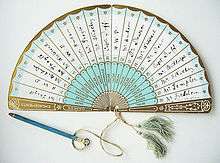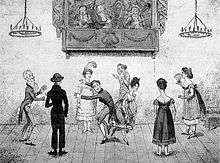Quadrille
The quadrille is a dance that was fashionable in late 18th- and 19th-century Europe and its colonies. The quadrille consists of a chain of four to six contredanses, courtly versions of English country dances that had been taken up at the court of Louis XIV and spread across Europe. Latterly the quadrille was frequently danced to a medley of opera melodies.

Performed by four couples in a rectangular formation, it is related to American square dancing. The Lancers, a variant of the quadrille, became popular in the late 19th century and was still danced in the 20th century in folk-dance clubs. A derivative found in the Francophone Lesser Antilles is known as kwadril, and the dance is also still found in Madagascar and is within old Caribbean culture.
History

The term quadrille originated in 17th-century military parades in which four mounted horsemen executed square formations. The word probably derived from the Italian quadriglia (diminutive of quadra, hence a small square).
The dance was introduced in France around 1760: originally it was a form of cotillion in which only two couples were used, but two more couples were eventually added to form the sides of a square. The couples in each corner of the square took turns, in performing the dance, where one couple danced, and the other couples rested. The "quadrille des contredanses" was now a lively dance with four couples, arranged in the shape of a square, each couple facing the center. One pair was called the "head" couple, the adjacent pairs the "side" couples. A dance figure was often performed first by the head couple and then repeated by the side couples. Terms used in the dance are mostly the same as those in ballet, such as jeté, chassé, croisé, plié and arabesque.
Reaching English high society in 1816 through Lady Jersey, the quadrille became a craze. As it became ever more popular in the 19th century it evolved into forms that used elements of the waltz, including The Caledonians and The Lancers. In Germany and Austria dance composers (Josef Lanner and the Strauss family) composed for the quadrille. Its popularity made it a metaphor, the "stately quadrille", of the constant formation of fresh political alliances with different partners in order to maintain the balance of power in Europe. Lewis Carroll lampooned the dance in Alice's Adventures in Wonderland's "The Lobster Quadrille" (1865).
Though new music was composed, the names of the five parts (or figures) remained the same, as did the steps and the figures themselves. The parts[1] were called:
- Le Pantalon ("Trousers")
- L’été ("Summer")
- La Poule (The Hen")
- La Pastourelle ("The Shepherd Girl")
- Finale

All the parts were popular dances and songs from that time (19th century): Le Pantalon was a popular song, the second and third part were popular dances, La Pastourelle was a well-known ballad by the cornet player Collinet. The finale was very lively.
Sometimes La Pastourelle was replaced by another figure; La Trénis. This was a figure made by the dance master Trenitz. In the Viennese version of the quadrille both figures were used: La Trénis became the fourth part, and La Pastourelle the fifth, making a total of six parts.[2]
The quadrille – musical analysis
Thus the quadrille was a very intricate dance. The standard form contained five different parts, and the Viennese lengthened it to six different parts. The following table shows what the different parts look like, musically speaking:
- part 1: Pantalon (written in 2
4 or 6
8)- theme A – theme B – theme A – theme C – theme A
- part 2: Été (always written in 2
4)- theme A – theme B – theme B – theme A
- part 3: Poule (always written in 6
8)- theme A – theme B – theme A – theme C – theme A – theme B – theme A
- Part 3 always begins with a two-measure introduction
- part 4: Trénis (always written in 2
4)- theme A – theme B – theme B – theme A
- part 5: Pastourelle (always written in 2
4)- theme A – theme B – theme C – theme B – theme A
- part 6: Finale (always written in 2
4)- theme A – theme A – theme B – theme B – theme A – theme A
- Part 6 always begins with a two-measure introduction
All the themes are 8 measures long.
References
- Clarke, Mary (1981). The history of dance. New York: Crown Publishers. ISBN 051754282X. p. 97
- Bob Skiba, "Here, Everybody Dances: Social Dancing in Early Minnesota", Minnesota History, vol. 55, no. 5 (Spring, 1997), 220, available online, accessed May 3, 2011
See also
| Wikisource has the text of a 1905 New International Encyclopedia article about Quadrille. |
- Joseph Binns Hart, composer of quadrilles
Historically related forms of dance: